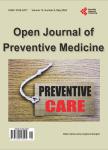Evaluation of Addiction among Students in First Year of a French University
Evaluation of Addiction among Students in First Year of a French University作者机构:Centre Addictologique Michel Fontan Centre Hospitalier Bélair Charleville-Mézières France Service Universitaire de Médecine Préventive et de Promotion de Santé Université Reims Champagne-Ardenne Reims France Observatoire du Suivi de l’Insertion Professionnelle et d’Evaluation Université Reims Champagne-Ardenne Reims France Unité d’Aide Méthodologique Université Reims Champagne-Ardenne Reims France Unité de Soins pour Adolescents Centre Hospitalier Bélair Charleville-Mézières France
出 版 物:《Open Journal of Preventive Medicine》 (预防医学期刊(英文))
年 卷 期:2016年第6卷第1期
页 面:42-56页
学科分类:0502[文学-外国语言文学] 050201[文学-英语语言文学] 05[文学]
主 题:Students Addiction Substance Abuse Prevalence France
摘 要:Background: We aimed to describe addictive behaviours and identify risk factors for addiction among students in their first year of university, which is known to represent a stressful situation conducive to the emergence of addictive behaviours. Methods: Ongoing cross-sectional survey among first-year students of the University of Reims Champagne-Ardenne (France). The first 16 months of the survey, which is due to run for 5 years, are analysed here. A self-report questionnaire was proposed to all first-year students during their mandatory preventive medicine consultation. The questionnaire kit comprised validated questionnaires evaluating addiction to alcohol, tobacco, cannabis, cocaine, amphetamines, solvents, tranquillizers, hallucinogens, opiates, other drugs, internet, and gambling or games of chance. Results: In total, 1139 students were included in this analysis;participation rate was 94% among all those invited to participate. Average age was 19 ± 1 years, male to female sex ratio was 0.54. Among respondents, 18% were at risk of addiction to alcohol, 2.3% were addicted;19.6% were smokers, and 5.5% were dependent. Cannabis was the most frequently used illicit substance, with 4.8% of students at risk, and 2 subjects addicted. For the internet, 11.6% of subjects were at risk, and 1.4% were addicted. By logistic regression, students receiving grants or whose parents have a low socio-professional category were at less risk of addiction to alcohol. We also found that students at risk were less likely to accept treatment. Conclusion: These initial findings show that certain addictive behaviours are particularly prevalent among first-year students, with identifiable risk factors or protective factors, thereby opening avenues for preventive and therapeutic measures.



